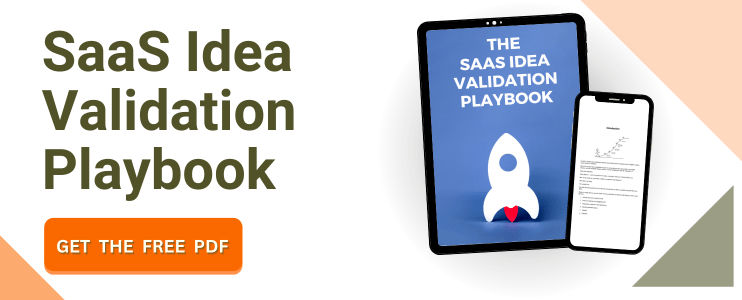Have you ever launched a SaaS product, convinced it would be an instant success, only to be met with complete silence?
Well, you may be surprised to hear this, but this happens more often than you think.
In fact, according to CB Insighits, 42% of new startups fail to find product market fit.
And if you've already launched a product, you know how much time, money, and effort goes into it.
And that's why starting with a solid product idea is critical.
So in this post, I'm going to share 7 tips to help you find the right product idea.
Here's a video version of this article if you prefer to watch instead.
1. Define your target business
Defining your target business profile helps you uncover potential problems you can solve for a very specific type of business.
The better you can articulate the problem these businesses are experiencing, the more your offer will resonate with them. And by solving the same problem over and over again for a particular type of business, you'll become more efficient at solving it.
And you can use that increased efficiency as an unfair advantage to become the best option in that market.
And you want to target businesses, not consumers, because business people think in terms of return on their investment (i.e., saving costs or increasing revenue).
When defining your target business, you want to be very specific about the industry or niche you want to work with and the market size, ensuring there is enough demand to sustain your business.
If there's competition in the market, that's a good thing. It means there are buyers as well.
2. Define your individual buyer
Your target buyer is someone working at your target business. So, it's not a business, but a person with a specific role in the business.
For example, it could be the founder, or the chief of technology.
Whoever it is, make sure you write it down, because all the marketing will speak to this person's goals, and in a language that is familiar to them.
Your marketing message will be much clearer if know who your talking to, and your sales pages will have higher conversion rates, as well.
One way find this person is to talk to any employee working at your target business and just asking them who you should talk to regarding the problem you want to solve.
You will quickly find the person you're looking for.
3. Find one big problem and available solutions
When you know what kind of business you're going for AND who your buyer is, it's time to figure out what are some of the problems they want to solve.
A great way to do that is to simply talk to them and find out what products they use, and why. Also, find out what they dislike about them.
By understanding what products they use, you'll understand what specific problems they need to solve. Because a product, is a solution to a specific problem.
Then, you might look at product reviews and see what others are complaining about. That's an easy way to find a unique value proposition for your product.
Also, their dissatisfaction with the current solution, or the benefits to switching to yours must be significant to justify the migration cost, which can sometimes be pretty high.
4. Track your KPIs
It's easy to get sidetracked when working on a product, especially if nothing seems to work the way you've hoped.
But most of the time it's because you're not tracking your Key Performance Indicators.
There are too many variables changing all at the same time, so you're flying blind, and it's impossible to see the forest from the trees.
That's why tracking your Key Performance Indicators can be so powerful. Because you can see things moving up and down, based on your marketing efforts.
And when you do, you know what activities are more likely to get you the results you're looking for.
Two of my favorite KPIs to track are the cost to acquire a user and the average lifetime value.
And that's because if the average lifetime value is higher than the acquisition cost, I know I can scale up by simply throwing money at getting more users.
But if the average lifetime value is lower than the acquisition cost, I need to look into increasing lifetime value or decreasing acquisition costs.
So these two KPIs are very actionable.
And of course, you should track a few more, but these two are my favorite.
5. Run small-scale experiments
When you have a bunch of painful problems that you know someone wants to fix, and you've established you Key Performance Indicators, it's time to get to work, and create your first experiment.
This could be a Minimum Viable Product, a presentation, or even just a bunch of conversations.
You want to understand as quickly as possible if this problem is worth solving for your buyer, and how much solving the problem is worth to them.
It's unlikely you're going to find the best problem to solve on the first try. So, you're probably going to iterate a few times until you find it. And that's why moving quickly is important.
If you have any tools that can help you moving quickly through those experiments, use them. For example, I use Ruby on Rails to build Minimum Viable Products, because I can test a SaaS idea really quickly.
So use whatever you can, to speed up this process.
6. Add more value
After you've gone through a few small-scale experiments, you'll have a some results.
And based on those results, you can tell if your solution is worth improving or if it's just not worth it.
For example, you may decide that you're slightly off track with your KPIs, and that you can improve them by continuing to add value to your service such that your churn rate goes down increasing your customer's lifetime value.
That's because if a user stays with you for longer, they'll pay more, and thus their lifetime value increases.
But something to consider here is that it's unlikely you're going to stumble upon the perfect idea on the first try. So it's worth trying to improve your offer a little bit, especially if you have users that can tell you what they like and don't like.
Maybe you're idea is close, and with a little added value you can get it to where it makes sense financially. Just give it some time before you discard it completely.
7 Find a different problem to solve
If you find that you're way off track with your idea, and there's nothing you can do to steer the ship around, then you'll want to go back to finding a different problem to solve and repeat the process.
You'll get there eventually by testing different problems, and different solutions to those problems. But it takes patience, and sometimes many iterations.
And obviously, the faster you can spawn new variants, the faster you'll find it.
One thing that can tell you if you're going in the right direction is competition. If there is enough competition in the market, it means there is demand for that product or service.





